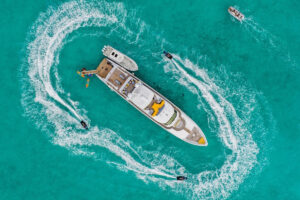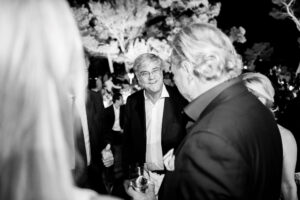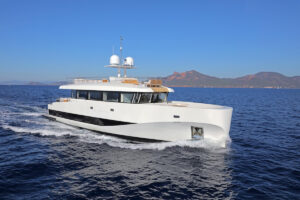Reggie Fountain is a one-man funnel cloud, whirling through life, lifting up people and things, depositing them along the way-perhaps dazed, as in the case of people, but seemingly happy. At the moment, he is conducting a tutorial on the intricacies of running his big, triple-engine 48 Express Cruiser. Rapt and wrapped in his discourse is Phoenix neurosurgeon Marc Letellier, new owner and pupil.
Reggie is very concerned about the boat’s performance. The problem is, Dr. Letellier wants to customize the boat so he and his wife, Madeleine, can cruise in complete comfort and independence. Toward that end, he has installed a washer and a dryer, a dishwasher, a trash compactor, and has placed a RIB dink with inboard engine on the swim platform. Further, he wants to add a hard top with air conditioning and put 300 feet of chain in the bow. At this point, the boat already has a tough time digging out of its own hole.
Reggie is muttering imprecations and mumbling about new, bigger props. Above all, he is determined to see that le docteur et la femme (they are French Canadian by birth and upbringing) realize their dream. If you want to add a new definition of “determined to your lexicon, spell it R. M. Fountain Jr.
Also aboard with us, and paying close attention to Reggie as well, is Fountain Powerboats’ new dealer in Greece, Alex Zeis.
As this mini drama unfolded, we were already a day late in leaving the Fountain factory in Little Washington, North Carolina. Our intention was to cruise to the Isle of Palms in South Carolina, play a round of golf on the Links course at the Wild Dunes resort, spend the night, cruise to Hilton Head Island, play the Harbour Town Links, spend the night in the new Inn at Harbour Town. And so on. Maybe even stop in my hometown of Beaufort and have lunch.
The verb tense in that second sentence is incorrect. It should read “had been, as you shall see.
The itinerary was supposed to include a late afternoon departure from Washington, a stopover at Reggie’s condo in Morehead City, and thence down to South-by-God. In fact, we didn’t leave the factory until the following morning at 11:30. We angled down the Pamlico River and cut into the ICW, arriving at 12:15 at the tiny hamlet of Hobucken, where we slowed to a crawl to spare the U.S. Coast Guard station and a couple of shrimp boats.
Hobucken is famous in the Attaway family history. It was here that my wife, Robyn, and I spent the night tied up to the shrimp docks, hiding from a nor’easter and unable to round Maw Point. For amusement, I rigged a spin rod and sat Miz Rob down on the transom, deliciously cute in her rain slicker, to fish. She promptly caught a toad fish.
“God,” I said, taking the ugly thing off the hook, “there’s only one thing I hate more than toad fish, and that’s eels.”
So, she caught an eel next.
The marriage not only has survived, it has blossomed.
On this calm day, Maw Point was moot and we skimmed across the Neuse, leaving the sailing village of Oriental to starboard half an hour later and turned into the Adams Canal.
The boat was loaded with people, gear, fuel and water, but Reggie decided we should take on some extra fuel for the dash to the Isle of Palms. We stopped at the fuel dock in Morehead City and Reggie, ever the host, went next door to a seafood restaurant and bought two pounds of lump crabmeat and cocktail sauce for lunch.
Nevertheless, it was 2:30 before we left Morehead and I, with a sense of foreboding, telephoned ahead and arranged to shift our tee time at Wild Dunes from four that afternoon to 7:30 the next morning. It was still a possibility.
At Morehead, we left the sanctuary of the Intracoastal and headed out Beaufort Inlet, intending to run straight to the Isle of Palms. Open ocean all the way. No “no-wakes. The Fountain 48 would come into its own and we would cruise in excess of 50 mph.
There was a mitigating circumstance that no one had considered: the dinghy didn’t like being tethered to its newly constructed cradle. It wanted off. Off the swim platform. We soon realized it probably would wrench itself free. This precipitated numerous stops to lash it in place. Result: by eight that evening, we had managed only to get to Murrell’s Inlet, just south of Myrtle Beach. We wanted to run inside again where we could make better time. Much better time.
We made another discovery: you can’t get to the ICW from Murrell’s Inlet. Our only real choice was to continue on down to Winyah Bay. That took another hour and the sun was rapidly sliding behind a cloud bank. We needed to find a place to spend the night-and soon.
“What do you know about Georgetown?” Reggie asked.
“I used to play patty-fingers in the dunes at church camp with a girl from there,” I offered hopefully.
Clearly, local knowledge on my part was of no use.
At 9 p.m., we turned into the ship channel in Winyah Bay and headed up toward Georgetown. The Furuno chart plotter kept us safely in the channel.
We tried to ask directions from the crew of a very long tow, a dredge and its accoutrements, but they ignored us. I spotted a tour boat headed toward a blinking string of lights that we took to be town. I urged Reggie to follow it.
Eventually, we caught up to it as it paused along Georgetown’s historic waterfront. The captain indicated a marina nearby and we tied up with the assistance of a couple on a handsome old Chris-Craft motoryacht.
Reggie and I (we have our priorities in order) raced up Front Street to a restaurant and secured a table for all before the kitchen could shut down. Just as we sat down, Reggie’s airplane pilot, Dave, and a professional captain, Ken Lohr, arrived. Afterward, Reggie, Alex and the pilot split to fly back to Little Washington, and Ken and I hired two locals to take us to a motel. There were no taxis about. Marc and Madeleine were snug on the boat.
The next morning, we departed Georgetown, with Capt. Lohr in command-or rather, Marc at wheel and throttles under Ken’s watchful eye-beneath a heavy overcast. I still dreamed of a chilled Chardonnay and a seafood salad on Beaufort’s gentrified waterfront.
At noon, we skirted The Battery at Charleston, paused in the glorious marshes behind Wadmalaw Island to take a few photographs of the boat (there was a brief interpluvial of sunshine, which we took advantage of), after which the skies shut down again and we sped southward in a driving rain. Clutches of seabirds huddled disconsolate on oyster reefs. My daydreams of facing down Pete Dye’s fabled golf course were fading.
At 3:30 we found ourselves moderately stuck on a mud bank at Beaufort. My fault. Marc was at the wheel, but I was so busy pointing out landmarks and babbling about my Tom Sawyer-ish boyhood there that I failed to keep him in the channel, which swings wide to the right southbound and hugs the shoreline. It was a mistake that has been made by thousands of yachtsmen over the last century or three. They should mark it.
No problem. We backed off and I was quick to identify, from then on, local hazards, including the sticky Parris Island spit that looks so innocent at high tide.
We were greeted at Harbour Town Marina by sunshine and my old friend Porter Thompson, who had helped set everything up. It was too late to think of anything except dinner, so we consoled ourselves with a reservations at CQ’s-not easy to come by in high season. Porter managed to work some sort of magic.
There was further consolation in the cosseting luxury of the Inn, but, alas, I had to fly out the next morning. I remembered, however, my first encounter with Pete Dye’s masterpiece, the 17th hole. I looked out at the green, surrounded by sand, Pete’s signature railroad ties, and Lowcountry marsh and thought: “No way. I plunked down a ball, pulled out a seven iron and was so relaxed by the surety of that ball being lost that I knocked it stiff. Easiest birdie I ever made.
We won’t talk about the next hole or any of the preceding ones.
Next time. And there surely will be one. The concept of cruising and golfing the South Carolina coast is a viable one. Not to mention enviable.
Contact: Fountain Powerboats, (252) 975-2000; www.fountainpowerboats.com.









